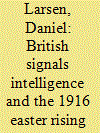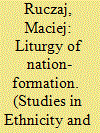| Srl | Item |
| 1 |
ID:
164183


|
|
|
|
|
| Summary/Abstract |
Historians for decades have placed Room 40, the First World War British naval signals intelligence organization, at the centre of narratives about the British anticipation of and response to the Easter Rising in Ireland in 1916. A series of crucial decrypts of telegrams between the German embassy in Washington and Berlin, it has been believed, provided significant advance intelligence about the Rising before it took place. This article upends previous accounts by demonstrating that Room 40 possessed far less advance knowledge about the Rising than has been believed, with most of the supposedly key decrypts not being generated until months after the Rising had taken place.
|
|
|
|
|
|
|
|
|
|
|
|
|
|
|
|
| 2 |
ID:
127031


|
|
|
|
|
| Publication |
2013.
|
| Summary/Abstract |
The Dublin 1916 Easter Rising is most often analysed in terms of the 'blood sacrifice' concept and its 'theatrical' aspect with both rhetorical devices being ascribed to Patrick (Padraic) Pearse - poet, dramatist, and a crucial figure in the development of the discourse of Irish nationalism. This article proposes a reading of Pearse's literary and political texts centred on the relation between the religious and the political. Starting with the delineation of the complex 'translation of the sacred' from the religious to the secular context, the article then examines the two above-mentioned key dimensions of the Rising, its sacrificial and 'theatrical' aspects, demonstrating their theological affinities. The two are interconnected through the thomistic theory of the liturgical sign, suggesting that the Easter Rising, as a crucial event in the construction of Irish nationhood, was devised and carried out per analogiam to the liturgical symbolism of the Catholic Mass.
|
|
|
|
|
|
|
|
|
|
|
|
|
|
|
|